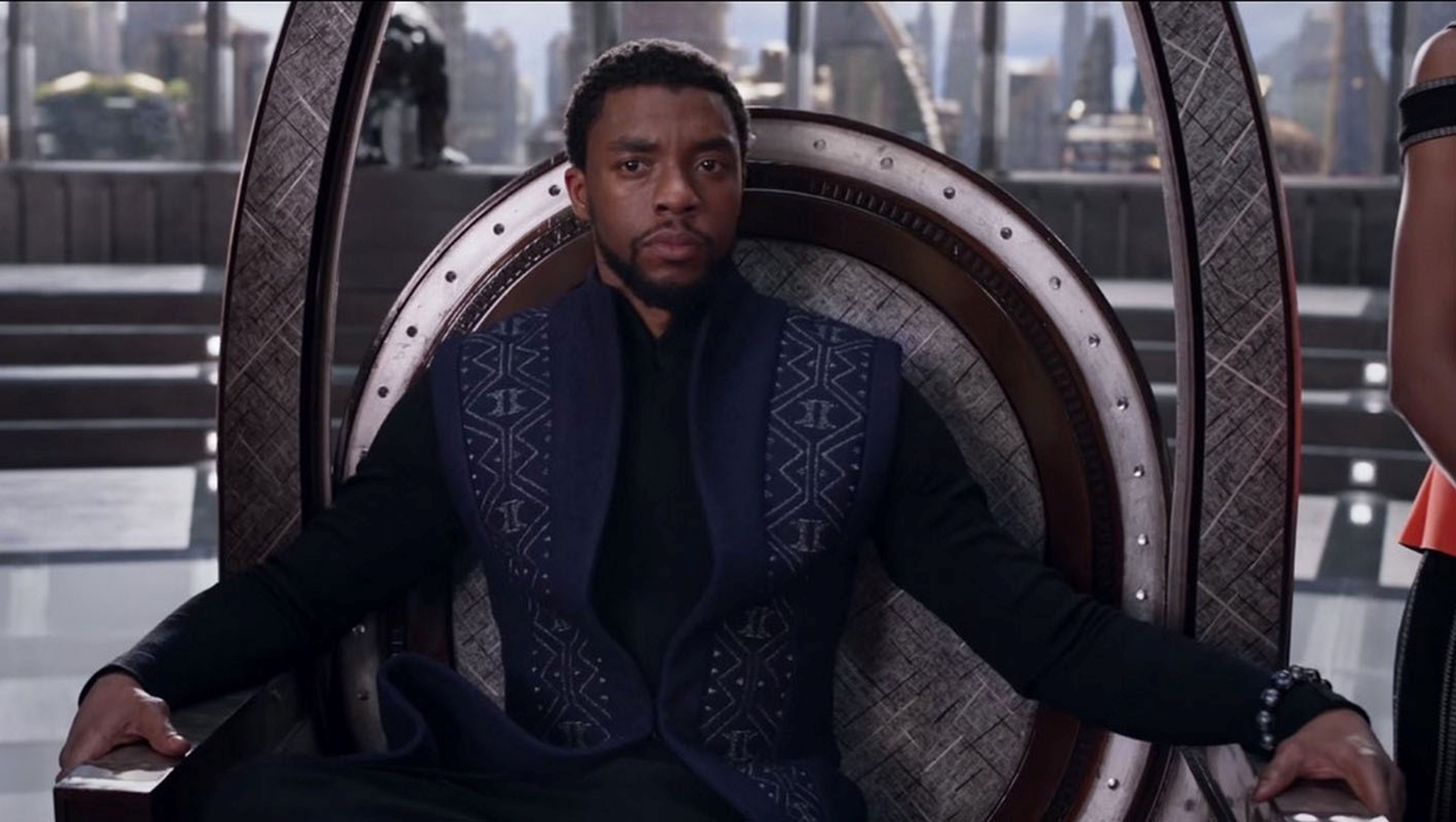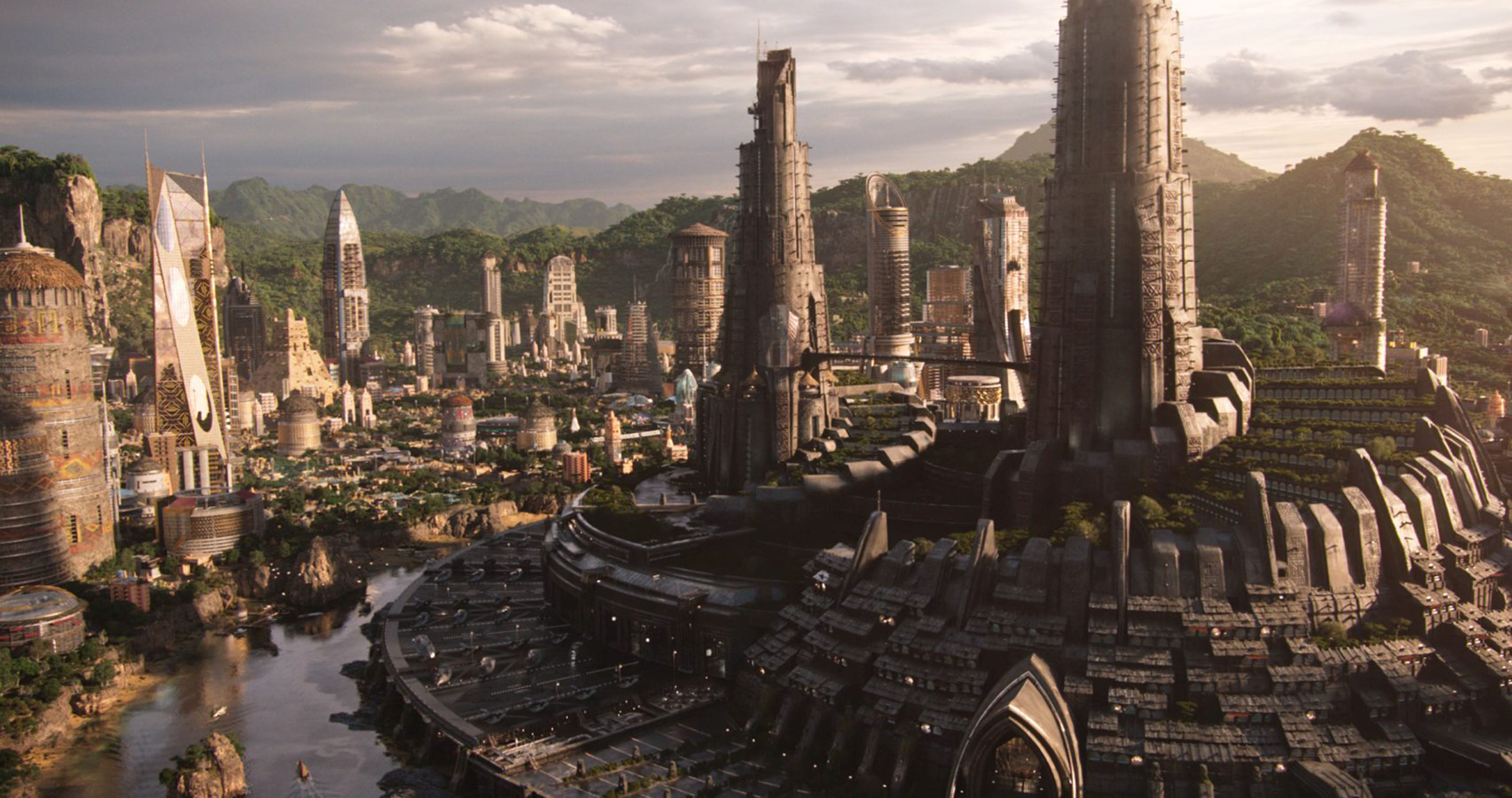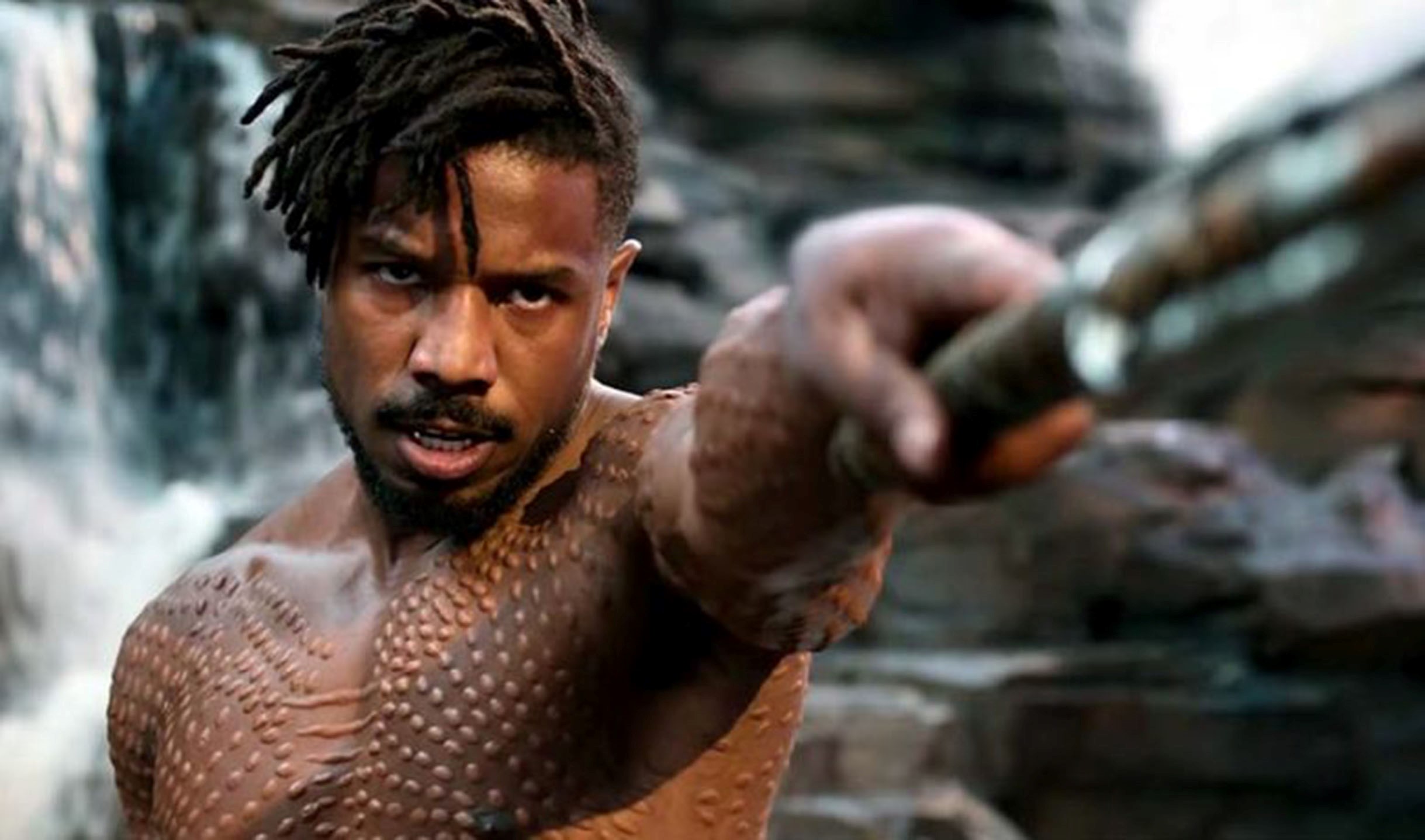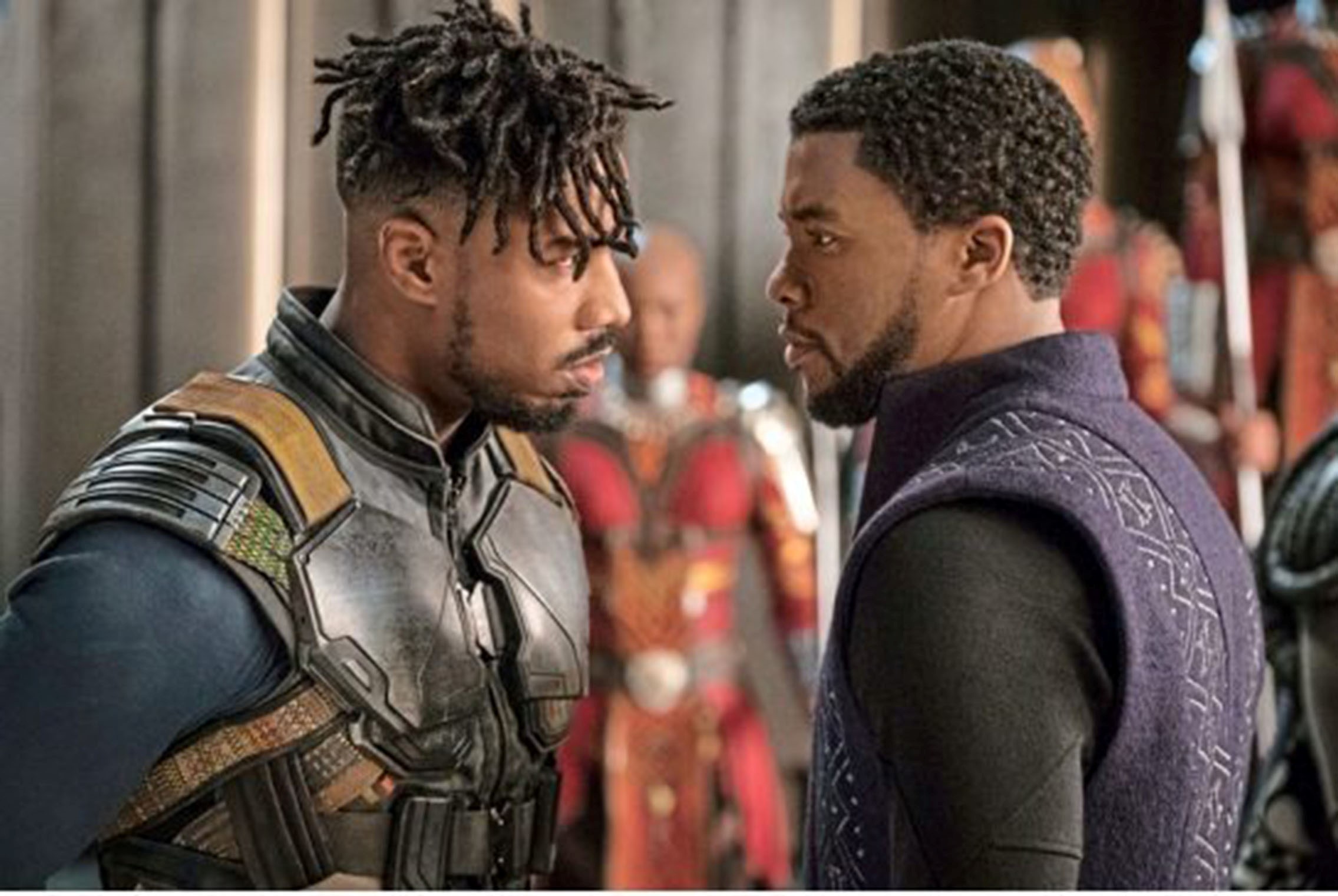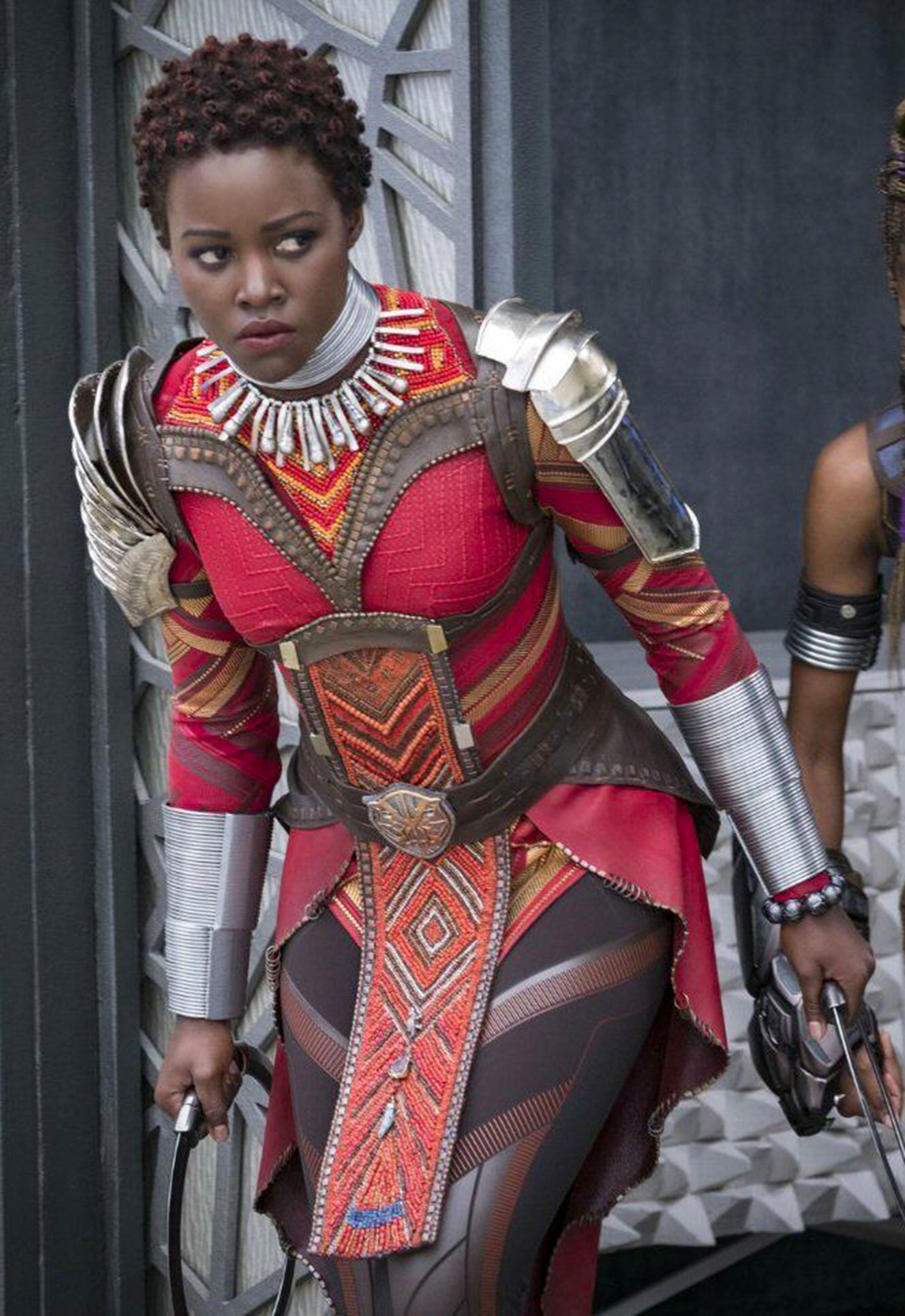T’Challa, Wakanda, and Afrofuturism
Black Panther opens with an animated sequence narrated by King T’Chaka, T’Challa’s father, explaining how Wakanda formed. This origin story is that a meteorite of Vibranium, a fictional metal that, in the Marvel universe, is the strongest, most versatile and valuable known substance, hit East Africa. Five tribes later settled the area. The tribes were constantly at war with each other until one tribe discovered the “Heart-Shaped Herb,” a plant mutated by Vibranium deposits. The king of one of the tribes ate the herb and was endowed with super-human powers. He became the first Black Panther and united four of the five tribes, creating the nation of Wakanda. The fifth tribe, the “J’Abari,” retreated to the Wakandan Mountains and refused participation in the social and cultural life of the nation.
The Wakandans mined Vibranium and created a civilization technologically and culturally far more advanced than any other on the planet. As Žižek14 explains in his Black Panther review, historically Africa’s wealth is also its curse as European (neo)colonial empires and multinational corporations continue to fund bloody conflicts over control of the continent’s natural resources. Wakanda avoided this by isolating itself from the world. Wakanda hid its resources so that the world believed it was a poor and largely uninhabitable area. Hiding in plain sight, Wakanda prospered as it watched Africa being torn apart by European powers, enslaving its populations and plundering its wealth.
That is what makes the idea of Wakanda so interesting; an African country untouched by colonialism, able to use its natural resources to develop a technologically sophisticated and culturally advanced society. Wakanda’s design is fiercely Afrofuturist in both its aesthetics and culture. Afrofuturism is a form of science fiction through a distinctly black cultural lens.15 As a vehicle for critical thought, Afrofuturism encourages experimentation, the re-imagination of identities, and, importantly, a Promethean vision of liberation.16
Much of Wakanda’s design comes from Jack Kirby’s original comic book as well as from Ta-Nehisi Coates’ newer illustrations.17 However the vast majority of the inspiration is the result of an extensive research trip that Ryan Coogler (director) and Hannah Beachler (production designer) took across Africa. The result is a unique utopian city that is very different than the “usual Tokyo-New York architectural mashup”18 seen in science fiction. The most vivid creation is the Wakandan capital, the “Golden City,” which is characterized as having cultural ties between nature and design. The skyscrapers topped with thatched roofs were inspired by the Three Rondavels, South African mountaintops that resemble traditional rondavel dwellings. When interviewed about the inspiration for the City’s design, Beachler stated
[We] researched architecture that we could find pre-colonization and imagined how it would have evolved between the 1400s and the turn of the century. And then seeing what exists in Nairobi and Lagos today, we started putting the Golden City together. [...] It was a mix of nature and the different tribes and cultures of Africa. [...] And then we had to incorporate vibranium in to all of that.19
Much of the commentary on Wakanda frames it within a utopian imaginary. Wakanda is the perfect embodiment of a utopian place. Utopia, which literally means “no place,” is a political imagining of a world that is not but could be, a present society itself in perfected form. “Utopias are thought- experiments, fantasies, and fictions that as well as performing a form of critique of the present also provide a political function. Utopia drives a politics of the present towards a future meaning.”20 Utopias drive political projects towards a future promised land and “operate as a mechanism of political excess’, providing a ‘justificatory apparatus of sacrifice.”21 The utopian promise of a more perfect future justifies all manners of horrors, in both deed and action. Utopias drive a politics of the present towards a future meaning that they are crucial to a temporal Promethean politics of acceleration. This is highly problematic, insofar as the fixation of a future-to-come forecloses the possibility of—as well as the desire for—any meaningful form of self-reflection as to the ethical and moral mechanism in which politics are carried out.22 A utopia is a fiction, but one that promises a perfect future. This promise engenders a desire to accelerate towards that future with the understanding that any forms of fascistic repression and violent means to achieve the promise can be retrospectively justified. The trick is that the utopic promise land does not and cannot exist, locking the subject into a permanent fascistic modality.23
To understand Wakanda as a utopia, we first have to accept its political temporization, that is to say its teleological notion of progress. The mythology of Wakanda is that of a constant and uninterrupted line of development. However, this came at a great human cost. Wakanda could have used its advanced technology to defend Africa from colonial invaders, but that would have exposed it to the world and opened it up to the risk of exploitation. Wakanda chose to hide from the world in order to protect its own citizens, and it achieved its utopian dream by sacrificing all other Africans. This has made the film appealing to the political Right. Both Dan McLaughlin, writing in the neoconservative National Review, and Ellie Bufkin, in the hyper-conservative The Federalist, notes that Wakanda’s brand of nationalism is instantly recognizable as a version of Trump’s “America First” doctrine:
Wakanda is racially homogenous, has no trade and no immigration, and is literally cut off from its neighbors by a big, beautiful wall. Wakanda’s worldwide network of spies exists solely to keep the country’s secrets [...] Wakanda is looking out only for Wakanda.24
Beyond its isolationist foreign policy, Wakanda’s domestic policies are also hyper-conservative. Despite the dominant roles that women play, it is a deeply patriarchal society ruled by a male monarch who has absolute power. The nation’s celebration of masculinity is most explicit when considering the line of succession. The crown passes exclusively from father to son, provided that no other male of royal blood challenges and wins the crown prince in ritual combat. As Bufkin writes,
Simply replace the geographic location, the race, and the language, and it really looks like the United States that some insist President Trump fantasizes about, if only coal had the power and value of Vibranium. I wonder if President Trump would think of himself as a dual-identity superhero/president.25
T’Challa is the dutiful and respectable prince who, after avenging his father’s death in Captain America: Civil War (2016), returns home and claims the crown by winning ritual combat against the leader of the Jabari Tribe, M'Baku. During the ceremony where T’Challa becomes king, he experiences a symbolic death and is transported to the “Ancestral Plane,” where he meets his father, T’Chaka. T’Challa states his ambition to be a “great king,” just like his father. T’Chaka answers that his son is a “good man with a good heart and it is hard for a good man to be a king.” T’Challa has every intention of continuing Wakanda’s isolationist policies. The sacrifice he must make to the “Wakanda First” doctrine is his moral sense of duty to other people suffering in Africa and around the world.
This moral flexibility should not be difficult for T’Challa. The privileged son of a wealthy homogenous nation, T’Challa would have no experience of race or racism. In other words, T’Challa would have no black consciousness. It is important here to remember Frantz Fanon’s reflections on race in Black Skin, White Masks.26 Fanon recalls how, growing up in colonial Martinique, he and other Martinicans did not identify as black, but as French, i.e. as white insofar as whiteness conveys a certain relationship to power. It was the Senegalese who they saw as black. Not until Fanon travelled to France and was forced to see himself in the racist gaze did he become aware of his racial position, suggesting that racial consciousness and racial identification comes about through the process of interpellation. It is through the process of being hailed that a person’s race is inscribed onto them. The Wakandans’ lack of a black consciousness is perfectly illustrated by T’Challa’s best friend (turned political enemy) W’Kabi: “When you let in refugees, they bring their problems with them.” The “refugees” in question here are other Africans. W’Kabi is stating the general Wakandan position that they view themselves as dominant in relation to other African peoples. This position is reinforced by Wakanda’s isolationist policies, which T’Challa is, at least initially, happy to continue.
Killmonger, Oakland, and Imperialism
Following the animated sequence, the first live-action scene in Black Panther takes place in Oakland, California in 1992. The scene opens with a panning shot of young boys playing basketball on a rundown court (to the soundtrack of Oakland rapper Too $hort) then it tilts up into an apartment in a housing project overlooking the court. Two Black men are plotting in a small apartment. The film doesn’t clarify what, although a revolutionary intent is implied by the apartment’s interior: a television in the background shows scenes of the 1992 Los Angeles riots that followed the arrest and beating of Rodney King and the walls (where a large armory of guns are hidden) are decorated with a large African print and a Public Enemy album poster for It Takes a Nation of Millions To Hold Us Back. 27
The men in the apartment are King T’Chaka’s brother, N’Jobu, and a Wakandan spy named Zuri. Radicalized by the suffering of poor black people, N’Jobu conspired with a smuggler and arms dealer named Ulysses Klaue to steal vibranium to arm black revolutionaries. The presumed intent was to instigate a revolution against the American government. When stealing the vibranium, Klaue killed several Wakandans. Unknown to N’Jobu, Zuri is also Wakandan and there to spy on him. T’Chaka arrives to take his brother home to be tried for his crime. N’Jobu tries to kill Zuri; T’Chaka saves Zuri by killing his brother. The pair leaves N’Jobu’s body in the apartment and return to Wakanda.
Events are complicated by the fact that one of the boys playing basketball outside is N’Jobu’s son, N’Jadaka, who will come to be known as Eric “Killmonger” Stevens. Both T’Chaka and Zuri knew that N’Jobu had a son with an American woman, but also that taking the boy back to Wakanda would be difficult, forcing them to publicly acknowledge that Prince N’Jodu committed treason. More importantly, it would also entail bringing someone of mixed-heritage into the homogenous nation. The politically expedient option was to leave the boy behind. He was the truth they needed to omit (to paraphrase Zuri) in order to maintain the political and cultural integrity of Wakanda.
Rather than being just another orphaned black, N’Jadaka vowed to continue his father’s revolutionary plans by dominating Wakanda and using its advanced technology to overthrow all anti-black racist and oppressive nations. Using the name Eric Stevens, N’Jadaka graduated from the Naval Academy Annapolis, attended MIT, joined the SEALS (Naval special forces) and fought in Afghanistan, where his aptitude for killing earned him the name “Killmonger.” He then joined a JSOC (Joint Special Operatives Command) ghost unit and learned the art of assassination and regime change. By his own admission, Killmonger killed “his own people” in Afghanistan, Iraq and on the African continent in order to gain the skills needed to lead a global revolution.
It is no coincidence that Black Panther’s director, Ryan Coogler, chose his hometown Oakland as Killmonger’s birthplace. Oakland has a long history of black radicalism. In the 1940s and 1950s, black people emigrated to Oakland en masse to work on the Southern Pacific Railroad. This was a prestigious job and workers were able to unionize and fight for liveable wages.28 Oakland is also the birthplace of the Black Panther Party.29 Formed just a few months after the Black Panther comic book character first appeared in Fantastic Four number 52 (July 1966),30 the Black Panther Party represents the most significant, and one of the most radical, mobilizations outside the American South during the Civil Rights movement.
Dissatisfied with the reformist approach of the Soul Students Advisory Council (SSAC), Huey P. Newton and Bobby Seale founded The Black Panther Party of Self Defense in 1966 with the idea of fomenting armed revolution from poor and working class people, the “brothers off the block” as they called them. For the Panthers, the brothers off the block were the lumpenproletariat that Fanon wrote about organizing.31 Newton and Seale agreed with Fanon that the violence of those from the street was reactionary and proportionate to the oppression they endured. They are the people who, “ain't gonna take no shit, brothers who had been fighting pigs.”32 Following Fanon’s thinking, the Panthers knew that once the brothers from the block are organized and have a political education they would become true revolutionaries.33
Much of the Black Panthers’ work focused on community building,34 however their decision to arm themselves drew national attention. During a protest on 2 May 1967, thirty legally armed Black Panthers entered the state Capitol building. Behind them followed a horde of journalists called to document the protest. Before they were arrested on felony charges of conspiracy to disrupt a legislative session, Bobby Seale delivered the Black Panther executive mandate to the gathered reporters.
Black people have begged, prayed, petitioned, demonstrated, and everything else to get the racist power structure of America to right the wrongs which have historically been perpetuated against black people. All of these efforts have been answered by more repression, deceit and hypocrisy. [...] City Hall turns a deaf ear to the pleas of black people for relief from this increasing terror.35
When Killmonger first meets T’Challa he similarly indicts Wakanda for turning a deaf ear on the suffering of black people across the world. Killmonger’s revolutionary intent is repeated after he appeared to kill T’Challa in ritual combat, was crowned king of Wakanda and became a second Black Panther. However his monologue as king takes a sharp imperialist turn when he declares:
I know how colonisers think, so I’m going to use their own strategies against them. We’re going to send vibranium weapons out to our War Dogs. They’ll arm oppressed people all over the world, so they can finally rise up and kill those in power and their children, and anyone else who takes their side. [...] The world’s going to start over and this time we’re on top. The sun will never set on the Wakandan Empire.
Paraphrasing the British colonial dream (the sun will never set on the British Empire), Killmonger reveals his colonial, imperialist aspirations and in doing so, reveals how his subjectivity has been mutated by his experience in the U.S. military. As much as Killmonger is a product of revolutionary Oakland, these desires have been over-coded and perverted by his participation in American imperialism. In his 1967 essay “Fear and Doubt,” Huey P. Newton writes that American ghettos are spaces that facilitate a limited form of subjectivity based on an internalization of inferiority, which leads to “a constant state of rage, of shame and doubt.”36 This, for Newton, is at the heart of reactionary and destructive violence. Killmonger’s internalization of this form of reactive violence is evident in his dialogue with T’Challa during their final fight scene:
T'Challa: You want to see us become just like the people you hate so much! Divide and conquer the land as they did!
Killmonger: Nah, I learned from my enemies. Beat them at they own game.
T'Challa: You have become them! You will destroy the world, Wakanda included!
Killmonger: The world took everything away from me! Everything I ever loved! But I'mma make sure we're even. I'mma track down anyone who would even think about being loyal to you! And I'm gonna put they ass in the dirt right next to Zuri!
Insofar as revolutionary change is taken to mean, “totally turning things upside down, a radical change in a sign-system [or] [...] the ontological transformation of the world,”37 despite his rhetoric, Killmonger is not advocating for revolution. Rather, he is reactively seeking to maintain the established order of Empire, but with a different face.
Liberation Theory and Dialectic Progress
Black Panther enacts key theoretical debates for black liberation, specifically the debates surrounding whether or not there exists an essential black consciousness and how best to decolonize. The movie ostensibly uses a dialectical logic to resolve the debate. The Dialectic is a theory of historical progress first proposed by Hegel that argues progress is achieved through a process of negative conflict. An established thought comes into conflict with its negative other. The result of this conflict is a new third form of thought. Marx applied this reasoning in his theory of historical materialism,38 arguing that historical progress emerges from conflict between two opposing forces. T’Challa begins the movie as an isolationist leader, lacking any form of racial consciousness. The film then introduces the character of Killmonger, a cultural nationalist and proponent of negritude who wants to violently liberate all black people. Their conflict results in a liberal form of international aid, with Wakanda opening educational and cultural centers in Oakland.
When he first meets T’Challa, Killmonger argues a theory of negritude:
Killmonger: You are all sitting up here comfortable. Must feel good. There's about two billion people around the world who look like us and their lives are a lot harder. Wakanda has the tools to liberate them all.
T'Challa: And what tools are those?
Killmonger: Vibranium. Your weapons.
T'Challa: Our weapons will not be used to wage war on the world. It is not our way to be judge, jury and executioner for people who aren't our own.
Killmonger: Not your own? Didn't life start here on this continent? So ain't all people your people?
T'Challa: I am not king of all people. I am king of Wakanda. And it is my responsibility to make sure that our people are safe and that vibranium doesn't fall into the hands of people like you.
While there are multiple interpretations of negritude, at its base, negritude is a response to colonialism that seeks to dis-alienate the colonized by articulating a unifying black identity, a singular black consciousness. Leopold Senghor, poet and the first president of Senegal, perhaps best defines negritude, as “referring not only to ‘the ensemble of values of the civilization of the black world’ but, more concretely and above all, to ‘a black manner of living’ or ‘a way of living as blacks.’”39 For Senghor,
“[A] black being [être Nègre] is not only a state [état], an ensemble of objective situations, but also a concrete action, of the black individual and the black collectivity: of black peoples. It is not a simple condition [état], a being-there, a Da-Sein, an acted-upon-being [être-agi]; it is above all an acting [agir].”40
Following this, we can understand Negritude as a form of strategically essentializing the racial position of all black peoples. However, understanding negritude as an act means that simply having black skin does not necessarily make one black. A being is black by acting black. As such, when Killmonger questions T’Challa’s right to be king of Wakanda, a nation he sees as being the heart of blackness, he is questioning T’Challa’s blackness.
Negritude is not without its critics, most significantly, Fanon. While Fanon admired the “fathers” of negritude, Senghor and Césaire, he nevertheless was sharply critical of negritude. In The Wretched of the Earth Fanon critiques Senghor as the archetypal “colonial intellectual,” who is “permeated by colonialism and all its ways of thinking.”41 Fanon notes two insurmountable problems with negritude. First is that culture is always first and foremost national, not racial.42 Even if the essentialization is strategic, affirming an essential black consciousness, it is still tied to, and therefore reproduces, colonialism’s Manichean worldview. This leads to the second problem with negritude; it lacks the ability to connect with other oppressed people outside of its racial category. Fanon notes that Senghor himself only supported decolonization for black-Africans, and supported French proposals for Algeria.43
Negritude is what Newton and Seale termed “cultural nationalism.” Cultural nationalists also essentialize blackness under the false assumption that they can return to a lost origin of authentic African culture that alone will liberate them. Cultural nationalists become “reactionary nationalists” who “are against other than black” and have no problem oppressing others.44 Cultural nationalism is intrinsically tied to the racist and colonial Manichean view. As such, it ultimately works to reinforce anti-black racism. When looking at this formation through the narrative of Black Panther, we see how Killmonger’s idea of Wakanda, understood as the heart of blackness, liberating all black people while dominating others situates his political ideology as a form of reactionary nationalism.
Killmonger’s drive to liberate all black people only to create a new Wakandan colonial empire perfectly enacts both positions: negritude’s “colonial intellectual” as well as the cultural nationalist. However, he apparently awakens a sense of duty to oppressed black people in T’Challa. In a manner of speaking, T’Challa did die when Killmonger threw him from the waterfall during ritual combat. T’Challa the conservative isolationist died so that T’Challa the progressive liberal could be born. The Dialectic is visibly acted out during the final fight where two Black Panthers fight to the death. The victor is neither isolationist or cultural nationalist, but a new Black Panther who looks to extend help to all oppressed people through U.N. style international aid and development programs.
Nakia and Pan-Africanism
While the argument that Black Panther follows a logic of dialectical progress is persuasive, it misses a key aspect, the role women play, specifically Nakia. Nakia is a Wakandan spy and T’Challa’s ex. However, her character is not reducible to the typical one-dimensional female love interest. Nakia’s intervention in the film is what drives T’Challa to end Wakanda’s isolationist policies. In fact, it was Nakia, not Killmonger, who first lobbied T’Challa to work towards the liberation of all oppressed peoples. As such, while overshadowed by the T’Challa/Killmonger conflict, it is Nakia who radically changes Wakanda and proposes a potentially revolutionary form of aid.
The first scene set in the present-day introduces Nakia, a spy on a mission to infiltrate a group seemingly styled after Boko Haram, and save their women captives. T’Challa interrupts her mission, requesting she return to Wakanda for the ceremony where he will be crowned king. Nakia accepts, but, when T’Challa asks her to remain with him in Wakanda, refuses to stay. In arguably the most important line of the film, Nakia states, “I've seen too many in need just to turn a blind eye. I can't be happy here knowing that there's people out there who have nothing.” She argues that Wakanda must provide aid, access to technology and refuge to those in need. This brief interaction is important for two reasons. First, it takes place before Killmonger is introduced, meaning that Nakia, not Killmonger, begins the process of changing T’Challa’s isolationist position. Second, as opposed to Killmonger, Nakia’s notion of liberation is not limited to racial categories. While Killmonger articulates a perverted notion of Senghor’s negritude, Nakia’s “calling” to liberate people who “have nothing” is closer to Fanon’s Pan-Africanism. Pan-Africanism, especially as it is understood in Fanon, is a form of socialist African unity and solidarity that crosses racial lines. This means that it avoids negritude’s problematic essentializing of black identity.
Pan-Africanism has, at its heart, a global commitment to decolonization. This commitment is political, as seen by the All-African People’s Conference in 1958 when the conference endorsed the creation of a new agency of international struggle, an “African Legion” that would fight in Algeria.45 Pan-Africanism’s commitment to decolonization is also cultural. Nowhere is this more obvious than in Fanon’s analysis of the role of culture on projects of colonial domination and anti-colonial resistance. Fanon writes that a key aspect of all colonial projects is to create a situation where in order to assimilate to the hegemonic culture (i.e. the oppressor’s culture) the native has to abandon their cultural heritage.46 This means that anti-colonial struggle must have, at its heart, a rejuvenation of native culture. Fanon famously argued that every culture is first and foremost a national culture, but colonialism was not limited to any one nation. For colonialism, the entire African continent, “was the haunt of savages, a country riddled with superstitions and fanaticism, destined for contempt.”47 To be revolutionary, anti-colonial national culture must be a living part of Africa, its land and its people.48 Indeed, Fanon’s “The Pitfalls of National Culture” is a prolonged critical reading of national culture with the aim of supporting the development of a Pan-African decolonial and revolutionary sensibility at the national level.
Fanon saw Pan-Africanism as being opposed to negritude. Fanon recognizes that negritude is the emotional antithesis to colonialism’s insulting views on native cultures. However, negritude’s unconditional affirmation of a black culture, “has succeeded the unconditional affirmation of European culture.”49 For Fanon, “culture founds a people only to the extent that it is creative [...] Returning to one’s roots is thus meaningless unless it is turned towards the future.”50 This is implicitly what Nakia is trying to create in Wakanda. When Nakia tells T’Challa that Wakanda should open itself up to the world and not only administer aid like other liberal states do, but “do it better.” “Better” here does not mean running lockstep with developmental IMF and World Bank policies. Nakia is implicitly suggesting a revolutionary form of outreach designed to liberate oppressed people.
Conclusion: Trilectics of Space and Place
Nakia’s character radically disrupts the possibility for reading Black Panther’s politics as dialectical. For that reason, it helps to look to Edward Soja’s concept of Thirdspace. Thirdspace provides us with a spatial practice of critique, construction and openness. It is
a place of critical exchange where the geographical imagination can be expanded to encompass a multiplicity of perspectives that have heretofore been considered by the epistemological referees to be incompatible, uncombinable. It is a space where issues of race, class, and gender can be addressed simultaneously without privileging one over the other.51
Thirdspace introduces a critical “other-than” choice that breaks dialectic thought and Manichean worldviews, opening thought up to endless alternative paths while rejecting the reduction to any singular ideological “unitary theory.”52 Thirdspace functions through a process of negotiation, not negation, of contradictory and antagonistic positions. This practice of negotiation opens up hybrid sites and objectives of struggle, destroying the negative polarity between theory and practical-political action.53 In other words, critique is less about overcoming an oppositional position than it is about creating space for dialogue and compromise. So, critical positions formed within Thirdspace abandon Manichean oppositions, opting instead for a more nuanced, transversal hybrid position.
Analysing Black Panther from this perspective allows a more nuanced understanding of the key theoretical debates underpinning the film. Through his interactions with Nakia and Killmonger, T’Challa develops a consciousness of being black. When he confronts his father and all other previous kings in the “Ancestral Plane” with their bankrupt ideological position, T’Challa radically breaks with Wakanda’s isolationism. Now T’Challa and, by extension, Wakanda have a choice: pursue a course of negritude and cultural nationalism as embodied by Killmonger, or opt for Nakia’s Pan-African approach to liberation?
The poverty of Killmonger’s ideological position quickly becomes evident. In much the same way that, as Fanon argues, Senghor’s notion of negritude and his cultural nationalism ended up reinforcing French cultural superiority,54 Killmonger’s form of liberation only reinforces the hegemony of colonial power. Killmonger’s ideological position cannot bear the weight of scrutiny, and in the end his form of “liberation” is a reactionary and suicidal drive to mutual destruction. Nevertheless, Killmonger’s pain is very real, and his fidelity to his ideological convictions – his choice to die rather than be locked up – illustrates the complex way in which colonialism creates specific traumas in the oppressed. These traumas manifest as reactionary and self-destructive forms of violence.55 That T’Challa can see how N’Jadaka became Killmonger is undoubtedly why the numerous think pieces about Black Panther find it difficult to reduce the character of Killmonger to a simple villain in the Marvel Universe.56
At the close of the film, we know that Wakanda will embark on a radical Pan-African form of international solidarity, rather than a bland and ineffective liberal form of aid, by Nakia’s inclusion in the state’s new internationalism. In the final scene with T’Challa and Nakia, T’Challa thanks her for “saving the nation.” He then proposes a way for Nakia to stay in Wakanda and still fulfil her “calling,” her Pan-African commitment to liberation. The following scene returns to the basketball court where the film opened. T’Challa and his sister, Shuri, are there discussing the plans to open the first Wakandan International Outreach Centre. Shuri, who is also fiercely anti-colonial and rebellious to Wakanda’s isolationism, will head up “tech and development” while Nakia will lead social outreach. Placing two anti-colonial/Pan-African women in charge of Wakanda’s outreach program suggests a far more radical vision of aid than liberalism could articulate. The film ends with Wakanda adopting a new hybrid ideological position. This position is the result of a negotiation between sovereignty and solidarity positions. Importantly, had the film simply been about dialectical negation, Killmonger’s suicidal position would have given way to a form of bland liberalism. However, the negotiation informed by Killmonger’s trauma and Nakia’s Pan-Africanism allowed for a more nuanced and critical way forward. This Thirdspace position has the potential to create new spaces and transform the Oakland housing project where T’Chaka kills Killmonger’s father into a space of liberation.
Author Biography
Anthony Faramelli lectures in Visual and Cultural Theory at Goldsmiths College. He is the author of Resistance, Revolution and Fascism: Zapatismo and Assemblage and has published widely in the areas of psychosocial theory, postcolonial theory, indigenous resistance and contemporary French philosophy. His current research is on Institutional Psychotherapy with a specific focus on Fanon and Guattari. Anthony also works in mental health as a Recovery Coordinator at the charity SHP.
